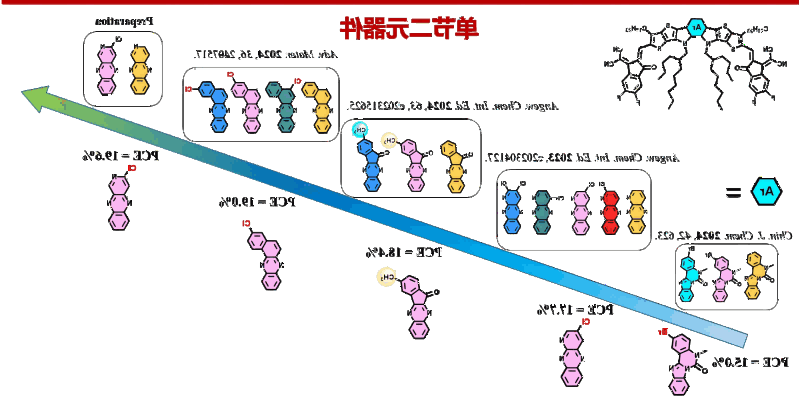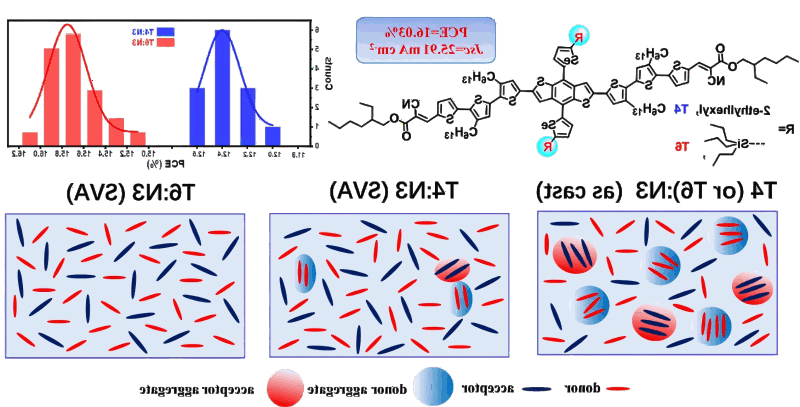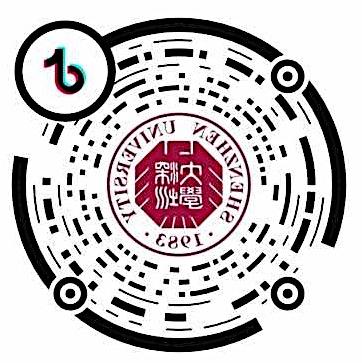Recently, Professor Yang Chuluo/Associate Professor Luo Zhenghui, School of Materials, Shenzhen University, has made a series of latest progress in the design and synthesis of organic photovoltaic materials and device research, and has been published in a series of high-level journals Adv. Mater. (影响因子27.4)、Angew. Chem. Int. Ed.(2篇,影响因子16.1)、Energy Environ. Sci.(3篇,影响因子32.4)、Natl.Sci. Rev. (影响因子16.3)、Adv. Energy. Mater.(影响因子24.4)、Adv. Funct. Mater.(2篇,影响因子18.5) Published research papers successively, and Associate Professor Luo Zhenghui is the first author or corresponding author of the above papers。
Organic solar cells (OSCs) have the advantages of lightweight, flexibility, transparency, large-area printing and processing with solution, and are gradually becoming the core component of photovoltaic technology。In the past decade, innovations in organic photovoltaic receptor materials, particularly the adoption of acceptor-donor-acceptor (A-D-A) and acceptor -(donor-acceptor 1-donor) -acceptor (A-DA), have been made1D-A type small molecule receptors (SMAs), which promote the significant development of OSCs。通常,A-DA1D-A structured SMAs have a banana-like molecular configuration that facilitates multimodal stacking, forming a dense 3D network structure, and increasing charge transport channels。通过对A-DA1By fine-optimizing the end groups, central nuclei and side chains of D-A type SMAs, the researchers have successfully exceeded 20% photoelectric conversion efficiency (PCE) of single-junction OSCs, showing good commercial feasibility。
The photoelectric conversion efficiency (PCE) of single-junction OSCs was successfully exceeded 20%
进展一:新型缺电子单元基小分子受体实现稳定高效有机光伏电池
[1] T. Xu#,Z. Luo*#, R. Ma*, Z. Chen, T. A. Dela Pena, H. Liu, Q. Wei, M. Li, C. Zhang, J. Wu, X. Lu, G. Li*, C. Yang*,Angew. Chem. Int. Ed.2023,62, e202304127.(共同一作+共同通讯)
[2]W. Wei#, C. Zhang#, Z. Chen#, W. Chen, G. Ran, G. Pan, W. Zhang, P. Buschbaum, Z. Bo, C. Yang,Z. Luo*,Angew. Chem. Int. Ed.2024,63, e202315625.(独立通讯)
[3]Z.Luo*, W. Wei, R. Ma*, G. Ran, M. H. Jee,Z. Chen, Y. Li, W. Zhang, H. Y. Woo, C. Yang*,Adv. Mater.2024, DOI: 10.1002/adma.202407517.(独立一作+共同通讯)

近几年来,随着A-DA1With the emergence of D-A type SMAs materials, the device efficiency (PCE) of OSCs has achieved rapid development。目前高性能的A-DA1The D-A SMA system is mainly based on side chain modifications such as L8-BO and BTP-eC9, but the rules for designing efficient SMA through side chain modifications are not clear, resulting in the current only rely on "trial and error" to obtain high-performance materials。 与此同时,与侧链修饰相比,A-DA1The central nucleus of D-A type SMA also plays A crucial role in determining the efficiency of the OSC, but it has received less attention, especially for the lack of electron A in the center1单元。鉴于此,我们The electron-deficient unit pyridine was introduced into the central nucleus of quinoxaline and combined with a cascade chlorination strategy, a series of pyridine compounds [2,3-] were developedbQuinoxaline (PyQx) is a new electron-deficient SMA,Py1, Py2, Py3, Py4, and Py5,The effects of the position of chlorine atoms in PyQx (ortho, meso and para of N atoms in pyridine) and number (0~2) on the physicochemical properties, molecular packing and device performance of SMAs were systematically studied。The device results show that the PV device based on PM1:Py2 has obtained 17.73% PCE, much higher than PM1:Py1 (11.78%), PM1:Py3 (16.15%), PM1:Py4 (7.40%)及PM1:Py5 (15.87%) of device performance, which is also one of the highest efficiency of organic solar cells based on non-benzothiadiazole as the electron-deficient core of SMA。
In order to enhance the molecular accumulation between the central nuclei, we use indene [1,2-bQuinoxolin-11-one (Qxo) replaces PyQx as electron-deficient A1Three receptors, named Qo1, Qo2 and Qo3, were synthesized by the monomethylation strategy。Single crystal tests demonstrated that Qo2 exhibits tighter and more intermolecular hydrogen bond interactions, with interactions including C-H∙∙∙F and C-H∙∙ O。The device results show that PCE of binary OSC based on PM6:Qo2 is 18.4%, significantly higher than PM6:Qo1 (15.8%)、PM6:Qo3 (16.7%)和PM6:Qo4 (2.4%)的器件(图3)。Achieving excellent thermal stability is essential for the industrialization of OSCs。在充N2After 12 hours of continuous annealing at 65 ° C for the three groups of devices in the glove box, the PM6:Qo1 device efficiency decreased dramatically, retaining only 66% of the initial PCE, compared to Qo2 and QO3-based devices retaining more than 90% of their initial PCE。When the annealing time reached 252 hours, the QO2-based device showed excellent stability, retaining 82 of the initial PCE.8%,显著优于基于Qo1(57.1%)和Qo3(71.4%)的器件。
In order to improve molecular energy levels and crystallization properties, the research team replaced Qxo with benzo [a] benzine as electron-deficient A1基团发展了系列A-DA1The effect of the position of chlorine atoms in the BP unit on its optical/electrochemical properties, molecular packing behavior and battery performance was systematically investigated。The three chlorinated SMAs (NA2, NA3, and NA4) exhibit slightly reduced molecular energy levels and higher electron mobility compared to unchlorinated NA1。Density functional theory (DFT) calculations show that NA2 has the longest orbital overlap length and the tightest π-π packing distance between the end group and the central nucleus。After blending these NA series SMAs with PM6, the NA3-based devices processed with o-xylene (o-XY) showed the best PCE of 18.94%,高于NA1(15.34%)、NA2(7.18%)和NA4(16.02%)基器件。The lowest efficiency of PM6:NA2 devices is attributed to NA2's excessive self-aggregation characteristics, while the highest efficiency of PM6:NA3 devices is due to better exciton dissociation, diffusion, and collection behavior, as well as higher and more balanced charge transport characteristics。More importantly, the addition of D18-Cl to the PM6:NA3 binary blend further improves the film morphology, making the efficiency of the three components reach 19.75%(认证值为19.39%)。
Link to paper [1] : http://onlinelibrary.wiley.com/doi/epdf/10.1002/anie.202304127
Link to paper [2] : http://onlinelibrary.wiley.com/doi/epdf/10.1002/anie.202315625
Link to paper [3] : http://onlinelibrary.wiley.com/doi/10.1002/adma.202407517
进展二:Asymmetric side chains replace hydrogen bond assisted 3D network receptors to power efficient organic photovoltaic cells
[1]Z. Luo*#, Y. Gao#, H. Lai#, Y. Li, Z. Wu, Z. Chen, R. Sun, J. Ren, C. Zhang, F. He, H, Woo, J. Min, C, Yang,Energy Environ. Sci.2022,15, 4601. (独立通讯)
[2]Z. Luo*, T. Xu, C. Zhang, Chuluo Yang*,Energy Environ. Sci.2023,16, 2732. (独立一作+共同通讯)
[3] C. Zhang, R. Zheng, H. Huang, G. Ran, W. Liu, Q. Chen, B. Wu, H. Wang,Z. Luo*, W. Zhang, W. Ma*, Z. Bo*, C. Yang*,Adv. Energy Mater.2024, 14, 2303756.(共同通讯)

The side-chain modification of small molecule receptor (SMA) is an effective method to achieve high device efficiency in organic solar cells (OSC), and the asymmetric side-chain strategy is a promising one。The single crystal structure of SMAs with symmetrical alkyl chains has long been shown to provide insight into the intrinsic properties of the corresponding molecules, such as molecular stacking, electron coupling, and charge transport properties, which in turn will facilitate the development of future high-performance SMaS。然而,迄今为止,No research work has focused on combining detailed single crystal data and density functional theory (DFT) calculations to explore the effects of SMAs containing asymmetric side chains on molecular packing, electron coupling, crystal packing, and cell efficiency,This is mainly because the strongly disordered asymmetric side chain makes it difficult to obtain high quality single crystals。Therefore, it is very important to study the intramolecular and intermolecular forces of SMA with asymmetric side chains at the atomic level using single crystal structures, and to correlate the basic information of single crystals with the morphology of pure receptor and blend membranes and device properties。In light of this, Zhenghui Luo et al., Shenzhen University, have for the first time filled this gap by focusing on the bulk molecules Y6 and BTP-PhC6 and the corresponding asymmetric molecule BTP-PHC6-C11 (originally synthesized here)。晶体学分析和理论计算结果表明,Due to the interaction of hydrogen bonds and the synergy of small steric hindrance,Asymmetric BTP-PHC6-C11 exhibits stronger π∙∙∙π interactions between the two terminal receptor units compared to symmetric Y6 and BTP-PhC6,3D电荷传输网络中的电子耦合更大,以及具有可比性的内部重组能。Finally, devices based on BTP-PhC6-C11 achieved the highest energy conversion efficiency (18.33%)。
Link to paper [1] : http://pubs.rsc.org/en/content/articlepdf/2022/ee/d2ee01848a
Link to paper [2] : http://pubs.rsc.org/en/content/articlepdf/2023/ee/d3ee00908d
Link to paper [3] : http://onlinelibrary.wiley.com/doi/10.1002/aenm.202303756
进展三:噻吩Pyrrolidine receptors power high performance photovoltaic devices with low energy loss
[1]Z. Luo*#, R. Ma#, J. Yu#, H. Liu, T. Liu*, F. Ni, J. Hu, Y. Zou, A. Zeng, C.-J. Su, U.-S. Jeng, X. Lu, F. Gao, C. Yang*, H. Yan*,Natl. Sci. Rev.2022,9, nwac076.(共同一作+共同通讯)
[2]Z.Luo*#, T. Liu*#, J. Oh#, R. Ma, J. Miao, F. Ni, G. Zhang,* R. Sun, C. Zhang, Z. Chen, Y. Zou, J. Min, C. D. Yang,* H. Yan, and C. L. Yang*,Adv. Funct. Mater.2022,32, 2203200.(共同一作+共同通讯)

The development and rational utilization of new building blocks is of particular importance for the design of high-performance organic photovoltaic materials, especially non-fullerene SMA。In most cases, thiophene, thiophene [3,2-]b]噻吩及其衍生物是最常用的结构单元。Compared with thiophene, pyrrole is the most electron-rich five-membered aromatic ring, which can reduce the optical band gap and raise the LUMO level of the molecule。Similarly, tricyclodithiophene with pyrrole [3,2-b:2',3'-dPyrrole (DTP) gives SMAs some special properties, including a small band gap and shallow LUMO energy levels。To date, almost all of the nitrogenated structural units of SMA are composed of monocyclic pyrrole or tricyclic DTP, while the application of bicyclic thienyl [3,2-b] pyrrole (ThPy) as a structural unit to non-fullerene SMA, and even to the entire field of organic electronics, has received little attention。Based on this, we developed four new A-D-A type SMA (ThPy1, ThPy2, ThPy3 and ThPy4) using the new ThPy as the building block.。Among them, ThPy1 and ThPy4 are a pair of isomers with a centrosymmetric structure, and ThPy2 and ThPy3 are another pair of isomers with an asymmetric central nucleus。The difference between the two molecules in each isomer pair is the location of the pyrole ring in the central nucleus: the pyrole ring in ThPy1 and ThPy2 is located outside the central nucleus, while the pyrole ring in ThPy3 and ThPy4 is located inside the central nucleus。Compared with the contrast molecule IT-4Cl, the four ThPy based receptors exhibit absorption redshift and upshift of the front orbital energy level due to the strong electron donating ability of pyrrole。密度泛函理论(DFT)计算表明,Compared to ThPy1 and ThPy2 (N atoms outside),IT-4Cl, ThPy3, and ThPy4 (N atoms in) exhibit relatively small torsion angles due to non-covalent interactions within S•• O molecules,It is very helpful to improve molecular packing and increase electron mobility。The device results show that the device based on PM6:ThPy3 achieves 15.With A 3% device efficiency (PCE) and A 77% fill factor (FF), this efficiency is one of the highest OSC values based on A-D-A type SMA。
Link to paper [1] : http://academic.oup.com/nsr/article/9/7/nwac076/6575013?searchresult=1
Link to paper [2] : http://onlinelibrary.wiley.com/doi/10.1002/adfm.202203200
(二)全小分子有机太阳能电池材料与器件
Small molecule solar cells have the advantages of precise structure, good device efficiency and repeatability, and are suitable for mass production. However, because the active layer topography is not easy to control, the device efficiency is lower than that of polymer solar cells. Therefore, a good interpenetrating network structural phase topography is crucial to the performance of small molecule solar cells。Generally, the phase morphology of small molecule batteries depends not only on the post-processing process of the device, but also on the structural properties of small molecule materials。In addition, in-depth understanding of the film formation mechanism of small molecule solar cell phase morphology is also of great significance to optimize the battery device and improve the performance。
进展一:High performance all-small molecule solar cells for slow film growth by controlling crystal deposition
[1] T. Xu#, J. Lv#, D. Zheng#,Z. Luo*, M. H. Jee, G. Ran, Z. Chen, Z. Huang, J. Ren, Y. Li, C. Zhang, H. Hu*, T. Pauporte´, W. Zhang*, H. Y. Woo*, C. Yang*,Energy Environ. Sci.2023,16, 5933.(共同通讯)

The research team gradually optimized the small molecule donor through end-group engineering and side-chain engineering strategies,Small donor T25 with cyanoester as end group was designed and synthesized respectively,T26 with rhodanine as end group and T27 with chlorine as side chain,The effects of end-group and side-chain engineering on the physicochemical properties of small molecule donors, the growth mechanism of active layer and the properties of the devices were systematically studied,Finally, small molecule batteries based on T27 achieved up to 16.8% device efficiency, one of the highest efficiency of binary small molecule batteries。When the film thickness of the active layer exceeds 300nm, the device efficiency can still remain above 15%, which is also one of the highest efficiency of the thick film of the binary small molecule battery。The physical and morphological analysis of the device shows that the hybrid membrane based on T27:Y6 has shorter exciton dissociation time, less influence of charge recombination and trap recombination, more balanced carrier mobility, closer molecular π-π packing, and better interpenetrating network structure。In addition, glow discharge emission spectroscopy (GD-OES) was applied to OSCs for the first time in order to study the aggregation and longitudinal distribution of acceptor molecules during the growth of the blend membrane。The results of in situ and off situ testing show that the binding degree of the acceptor and the growth rate of the film are closely related to the device performance。Compared with T26:Y6 and T25:Y6 blends, T27:Y6 blends had higher acceptor binding degree and slower film growth rate。These results provide further evidence for the high performance of T27:Y6。
论文链接:http://pubs.rsc.org/en/content/articlepdf/2023/ee/d3ee02129g
进展二:侧链工程和溶剂退火协同调控实现高性能全小分子太阳能电池
[1] T.Xu, J. Lv, Z. Chen,Z. Luo*, G. Zhang, H. Liu, H. Huang, D. Hu, X. Lu, S. Lu*, C. Yang*,Adv. Funct. Mater.2023,33, 2210549.(共同通讯)

The research team developed two novel small molecule donor materials, named T4 and T6。The two materials introduced alkyl and trialkyl silyl substituents on conjugated selenthiophene side chains, respectively。The results show that different side chain substituents have significant effects on semiconductor properties, film morphology and device efficiency。Compared with T4, the trialkylsilyl substituted T6 exhibits a deeper HOMO energy level, and the absorption spectrum is slightly blue shifted。When the two materials are mixed with the receptor N3, the resulting blend films exhibit significantly different properties。The untreated devices all showed poor performance, but when using carbon disulfide (CS2After annealing treatment, the photoelectric conversion efficiency of the corresponding devices is significantly improved, mainly due to the faster exciton generation rate and more favorable phase separation, forming an interpenetrating fiber network structure。In particular, T6-based thin film devices have achieved 16.The PCE of 03% is significantly higher than that of T4 devices (12.61%)。与T4器件相比,The PCE improvement of T6 devices is mainly attributed to the following points: First,T6 pure films have wider absorption range and deeper HOMO energy level,May bring higher short circuit current and open circuit voltage;secondly,T6-based devices show better exciton dissociation rate and charge collection efficiency,且电荷迁移率更为平衡,受复合影响较小;最后,These T6:N3 blended films show a stronger π-π packing effect and a more ordered molecular arrangement,以及更明显的纤维状互穿网络结构,有利于电荷传输。该研究系统探讨了侧链工程和CS2The effect of annealing on semiconductor properties and device performance demonstrates the great potential of side chain engineering and solvent annealing for improving photoelectric performance。
Link to thesis: http://onlinelibrary.wiley.com/doi/10.1002/adfm.202210549
The first completed unit of the above work is Shenzhen University, and Associate Professor Luo Zhenghui is the first author or corresponding author。I would like to thank the National Natural Science Foundation of China, Shenzhen Science and Technology Innovation Bureau and Shenzhen University for their support





